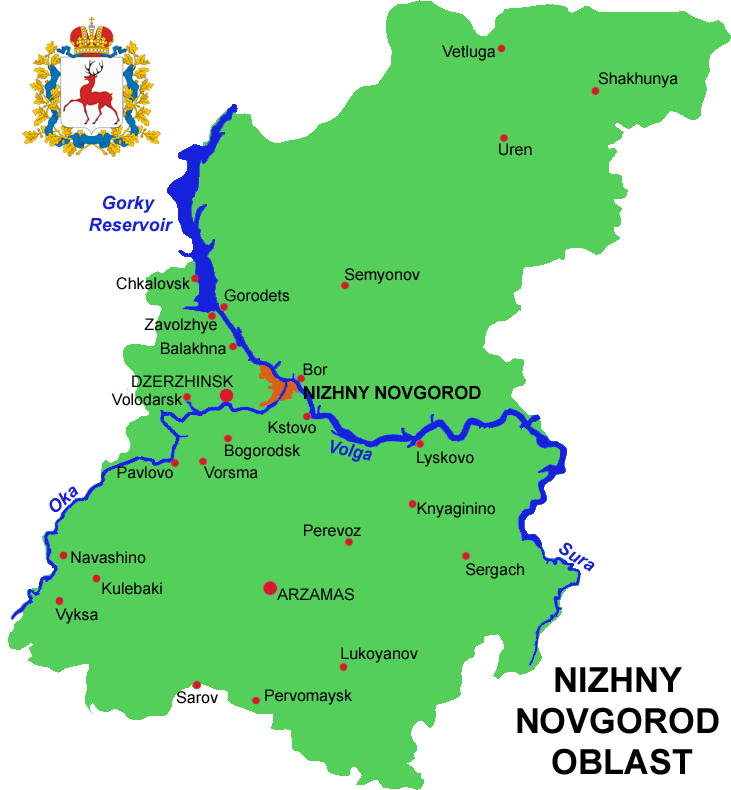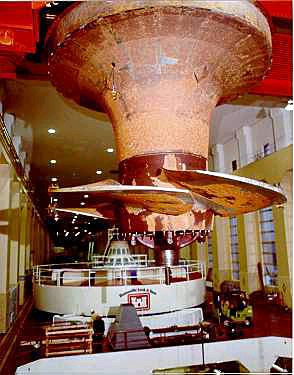|
Nizhny Novgorod Hydroelectric Station
The Nizhny Novgorod Hydroelectric Station or Nizhny Novgorod GES (russian: Нижегоро́дская ГЭС) is a hydroelectric station on the Volga river. Located near Zavolzhye, Nizhny Novgorod Oblast, it belongs to the Volga-Kama Cascade of dams. Technical data Construction started in 1948 and was completed in 1959. Complex consists of concrete spillway dam, 7 earth-fill dams and 3 dikes total 18.6 km long and up to 40 m high, power plant house, and two single-chamber two-lane locks with an intermediate pond. Installed power is 530.5 MW, average annual production is 1510 GWh. Power house has 8 generator units with Kaplan turbines at 17 m head. 6 units of 65 MW, one of 68 MW and one of 72.5 MW. The dam with total waterfront length of 13 km forms Gorky Reservoir. History Construction began in 1948. Although it was a medium-size project, e.g. compared to Volga Hydroelectric Station The Volga Hydroelectric Station or Volga GES (russian: Волжская ГЭС) ... [...More Info...] [...Related Items...] OR: [Wikipedia] [Google] [Baidu] |
Volga
The Volga (; russian: Во́лга, a=Ru-Волга.ogg, p=ˈvoɫɡə) is the List of rivers of Europe#Rivers of Europe by length, longest river in Europe. Situated in Russia, it flows through Central Russia to Southern Russia and into the Caspian Sea. The Volga has a length of , and a catchment area of «Река Волга» , Russian State Water Registry which is more than twice the size of Ukraine. It is also Europe's largest river in terms of average discharge (hydrology), discharge at delta – between and – and of drainage basin. It is widely regarded as the Rivers in Russia, national river of Russia. The hypothetical old Russian state, the Rus' Khaganate, arose along the Volga . Historically, the river served as an important meeting place of various Eurasian civilizations. The river flows in Russia through forests, Fo ... [...More Info...] [...Related Items...] OR: [Wikipedia] [Google] [Baidu] |
Zavolzhye, Nizhny Novgorod Oblast
Zavolzhye (russian: Заво́лжье) is a town in Gorodetsky District of Nizhny Novgorod Oblast, Russia, located on the right bank of the Volga River, opposite Gorodets, the administrative centre of the district, and northwest of Nizhny Novgorod, the administrative center of the oblast. Population: Etymology The name of the town literally means ''" he landsbeyond the Volga"'', i.e., on the river's ''left'' bank, since "beyond" here is taken relative to the historically more populated right bank of the river. Thus, Zavolzhye—the region in Nizhny Novgorod Oblast—normally refers to its forested and sparsely populated northeastern half. This makes the name of the town of Zavolzhye somewhat confusing for some people in the region, since the city is located on the ''right'' side of the river—it is only "beyond the river" with respect to much older Gorodets. History It was founded in 1950 as a settlement serving the construction of the Gorky Hydroelectric Station (now Nizh ... [...More Info...] [...Related Items...] OR: [Wikipedia] [Google] [Baidu] |
Nizhny Novgorod Oblast
Nizhny Novgorod Oblast (russian: link=no, Нижегородская область, ''Nizhegorodskaya oblast''), is a federal subjects of Russia, federal subject of Russia (an oblast). Its administrative center is the types of inhabited localities in Russia, city of Nizhny Novgorod. It has a population of 3,310,597 as of the Russian Census (2010), 2010 Census. From 1932 to 1990 it was known as Gorky Oblast. The oblast is crossed by the Volga River. Apart from Nizhny Novgorod's metropolitan area (including Dzerzhinsk, Russia, Dzerzhinsk, Bor, Nizhny Novgorod Oblast, Bor and Kstovo) the biggest city is Arzamas. Near the town of Sarov there is the Serafimo-Diveyevsky Monastery, one of the largest convents in Russia, established by Seraphim of Sarov, Saint Seraphim of Sarov. The Makaryev Monastery opposite of the town of Lyskovo, Nizhny Novgorod Oblast, Lyskovo used to be the location of the largest fair in Eastern Europe. Other historic towns include Gorodets, Nizhny Novgorod Oblast ... [...More Info...] [...Related Items...] OR: [Wikipedia] [Google] [Baidu] |
Kaplan Turbine
The Kaplan turbine is a propeller-type water turbine which has adjustable blades. It was developed in 1913 by Austrian professor Viktor Kaplan, who combined automatically adjusted propeller blades with automatically adjusted wicket gates to achieve efficiency over a wide range of flow and water level. The Kaplan turbine was an evolution of the Francis turbine. Its invention allowed efficient power production in low-head applications which was not possible with Francis turbines. The head ranges from and the output ranges from 5 to 200 MW. Runner diameters are between . Turbines rotate at a constant rate, which varies from facility to facility. That rate ranges from as low as 54.5 rpm (Albeni Falls Dam) to 450 rpm. Kaplan turbines are now widely used throughout the world in high-flow, low-head power production. Development Viktor Kaplan, living in Brünn, Austria-Hungary (now Brno, Czechia), obtained his first patent for an adjustable blade propeller turbine in 1912. But t ... [...More Info...] [...Related Items...] OR: [Wikipedia] [Google] [Baidu] |
Gorky Reservoir
Gorky Reservoir (russian: Го́рьковское водохрани́лище), known colloquially as Gorky Sea (russian: Го́рьковское мо́ре), is an artificial lake in the central part of the Volga River in Russia, formed by a hydroelectric dam of Gorky Hydroelectric Station (now called Nizhny Novgorod Hydroelectric Station) built in 1955 between the towns of Gorodets and Zavolzhye and filled in 1955 – 1957. It spans for 430 km from the dam of Rybinsk to the dam of Gorodets through Yaroslavl, Kostroma, Ivanovo and Nizhny Novgorod oblasts of Russia. While it is relatively narrow and follows the natural riverbed of Volga in the upper part, it becomes up to 16 km wide downstream the town of Yuryevets. The reservoir takes its name from the former name of the city of Nizhny Novgorod Nizhny Novgorod ( ; rus, links=no, Нижний Новгород, a=Ru-Nizhny Novgorod.ogg, p=ˈnʲiʐnʲɪj ˈnovɡərət ), colloquially shortened to Nizhny, fr ... [...More Info...] [...Related Items...] OR: [Wikipedia] [Google] [Baidu] |
Volga Hydroelectric Station
The Volga Hydroelectric Station or Volga GES (russian: Волжская ГЭС) also known as the 22nd Congress of the CPSU Stalingrad/Volgograd Hydroelectric Power Station (russian: Сталинградская/Волгоградская ГЭС имени XXII съезда КПСС), is the largest hydroelectric station in Europe, and it is the last of the Volga-Kama Cascade of dams, immediately before the Volga River flows into the Caspian Sea. It was the largest powerstation in the world between 1960 and 1963. Today, it is operated by the electricity company RusHydro. History Built as part of a massive postwar effort known as the Great Construction Projects of Communism, it was authorized by Joseph Stalin signing the Council of Ministers of the USSR order #3555 on 6 August 1950. The plan called for building a station north of the city of Stalingrad (modern Volgograd) with a minimum storage capacity of 1.7 million kWh. Ten thousand youths from the Komsomol league participa ... [...More Info...] [...Related Items...] OR: [Wikipedia] [Google] [Baidu] |
Transvolga
Transvolga Region or Transvolga (russian: Заволжье, Zavolzhye) is a territory to the East of Volga River bounded by Volga, Ural Mountains, Northern Ridge, and Caspian Depression. The region is traditionally subdivided into the elevated High Transvolga (Высокое Заволжье) in the East and the lowland Low Transvolga (Низкое Заволжье) by the left bank of Volga between Kazan and Kamyshin. The region includes Volga-Ural petroleum and gas province. Kuybyshev Reservoir is within the Low Transvolga. See also *Volga Region The Volga Region (russian: Поволжье, ''Povolzhye'', literally: "along the Volga") is a historical region in Russia that encompasses the drainage basin of the Volga River, the longest river in Europe, in central and southern European Russ ... Regions of Russia Volga basin {{volga-geo-stub ... [...More Info...] [...Related Items...] OR: [Wikipedia] [Google] [Baidu] |
Gorodets, Nizhny Novgorod Oblast
Gorodets (russian: Городе́ц) is a town and the administrative center of Gorodetsky District in Nizhny Novgorod Oblast, Russia, located on the left bank of the Volga River, northwest of Nizhny Novgorod, the administrative center of the oblast. Population: 34,000 (1970). History The town was founded in 1152 by Prince Yury Dolgoruky (also the founder of Moscow) as a large fortress on the Volga River, the first Russian fortress in today's Nizhny Novgorod Oblast. It was a starting point for numerous campaigns of the princes of Vladimir and Suzdal against Volga Bulgaria. In 1216, Yury II of Vladimir was dethroned by his brother and exiled here. In 1239, the town was burned to the ground by Batu Khan's army. Folk tradition identifies Gorodets with Little Kitezh, a legendary town destroyed by the Mongols. In 1263, Alexander Nevsky died in Gorodets on his way back to Novgorod from the Golden Horde. His son, Andrey, made the town his chief residence. A famous medieval ... [...More Info...] [...Related Items...] OR: [Wikipedia] [Google] [Baidu] |
Dams In Russia
A dam is a barrier that stops or restricts the flow of surface water or underground streams. Reservoirs created by dams not only suppress floods but also provide water for activities such as irrigation, human consumption, industrial use, aquaculture, and navigability. Hydropower is often used in conjunction with dams to generate electricity. A dam can also be used to collect or store water which can be evenly distributed between locations. Dams generally serve the primary purpose of retaining water, while other structures such as floodgates or levees (also known as dikes) are used to manage or prevent water flow into specific land regions. The earliest known dam is the Jawa Dam in Jordan, dating to 3,000 BC. The word ''dam'' can be traced back to Middle English, and before that, from Middle Dutch, as seen in the names of many old cities, such as Amsterdam and Rotterdam. History Ancient dams Early dam building took place in Mesopotamia and the Middle East. Dams were used ... [...More Info...] [...Related Items...] OR: [Wikipedia] [Google] [Baidu] |
Hydroelectric Power Stations Built In The Soviet Union
Hydroelectricity, or hydroelectric power, is electricity generated from hydropower (water power). Hydropower supplies one sixth of the world's electricity, almost 4500 TWh in 2020, which is more than all other renewable sources combined and also more than nuclear power. Hydropower can provide large amounts of low-carbon electricity on demand, making it a key element for creating secure and clean electricity supply systems. A hydroelectric power station that has a dam and reservoir is a flexible source, since the amount of electricity produced can be increased or decreased in seconds or minutes in response to varying electricity demand. Once a hydroelectric complex is constructed, it produces no direct waste, and almost always emits considerably less greenhouse gas than fossil fuel-powered energy plants. [...More Info...] [...Related Items...] OR: [Wikipedia] [Google] [Baidu] |
Hydroelectric Power Stations In Russia
Hydroelectricity, or hydroelectric power, is electricity generated from hydropower (water power). Hydropower supplies one sixth of the world's electricity, almost 4500 TWh in 2020, which is more than all other renewable sources combined and also more than nuclear power. Hydropower can provide large amounts of low-carbon electricity on demand, making it a key element for creating secure and clean electricity supply systems. A hydroelectric power station that has a dam and reservoir is a flexible source, since the amount of electricity produced can be increased or decreased in seconds or minutes in response to varying electricity demand. Once a hydroelectric complex is constructed, it produces no direct waste, and almost always emits considerably less greenhouse gas than fossil fuel-powered energy plants. [...More Info...] [...Related Items...] OR: [Wikipedia] [Google] [Baidu] |





